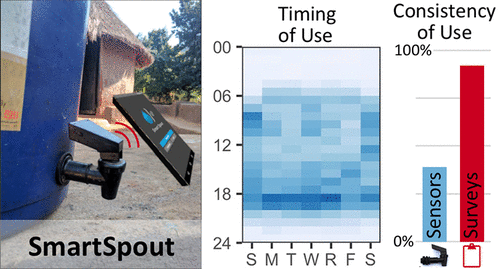当前位置:
X-MOL 学术
›
Environ. Sci. Technol.
›
论文详情
Our official English website, www.x-mol.net, welcomes your feedback! (Note: you will need to create a separate account there.)
Embedding Usage Sensors in Point-of-Use Water Treatment Devices: Sensor Design and Application in Limpopo, South Africa
Environmental Science & Technology ( IF 11.4 ) Pub Date : 2021-06-16 , DOI: 10.1021/acs.est.0c08683 David D Meyer 1 , Courtney Hill 2 , Kelly McCain 2 , James A Smith 2 , Pascal O Bessong 2, 3 , Elizabeth T Rogawski McQuade 2 , Natasha C Wright 1
Environmental Science & Technology ( IF 11.4 ) Pub Date : 2021-06-16 , DOI: 10.1021/acs.est.0c08683 David D Meyer 1 , Courtney Hill 2 , Kelly McCain 2 , James A Smith 2 , Pascal O Bessong 2, 3 , Elizabeth T Rogawski McQuade 2 , Natasha C Wright 1
Affiliation

|
Health benefits from point-of-use (POU) water treatment devices come only with consistent use. Embedded sensors can measure the consistency of POU-device use and can provide insights about improving it. We demonstrate both potentials with data from SmartSpouts: accelerometer-based sensors embedded in spigot handles that record the duration and timing of use. In the laboratory, most sensor readings correlated well (>0.98) with manually timed water withdrawals. In the field, SmartSpouts measured >60,000 water withdrawals across 232 households in Limpopo, South Africa. Sensors proved critical to understanding consistent use; surveys overestimated it by 53 percentage points. Sensor data showed when households use POU devices (evening peaks and delayed weekend routines) and user preferences (safe storage over filters). We demonstrate analytically and with data that (i) consistent use (e.g., 7 continuous days) is extremely sensitive to single-day use prevalence and (ii) use prevalence affects the performance of contact-time-based POU devices, exemplified with silver tablets. Deployed SmartSpouts had limitations, including memory overflows and confounding device relocation with water withdrawal. Nevertheless, SmartSpouts provided useful and objective data on the prevalence of single-day and consistent use. Considerably less expensive than alternatives, SmartSpouts enable an order of magnitude increase in how many POU-device sensors can be deployed.
中文翻译:

在使用点水处理设备中嵌入使用传感器:传感器设计和在南非林波波的应用
使用点 (POU) 水处理设备对健康的益处只有在持续使用的情况下才会出现。嵌入式传感器可以测量 POU 设备使用的一致性,并可以提供有关改进它的见解。我们利用 SmartSpouts 的数据展示了这两种潜力:嵌入在龙头手柄中的基于加速度计的传感器记录了使用的持续时间和时间。在实验室中,大多数传感器读数与手动定时取水良好相关 (>0.98)。在现场,SmartSpouts 测量了南非林波波 232 户家庭的超过 60,000 次取水量。事实证明,传感器对于理解一致使用至关重要;调查高估了 53 个百分点。传感器数据显示了家庭何时使用 POU 设备(晚高峰和延迟的周末例行活动)和用户偏好(通过过滤器安全存储)。我们通过分析和数据证明 (i) 持续使用(例如,连续 7 天)对单日使用流行率极为敏感,并且 (ii) 使用流行率会影响基于接触时间的 POU 设备的性能,例如银片. 部署的 SmartSpouts 存在局限性,包括内存溢出和设备重新定位与取水混淆。尽管如此,SmartSpouts 提供了有用且客观的数据,说明单日和持续使用的流行程度。SmartSpouts 比其他替代方案便宜得多,它可以将可部署的 POU 设备传感器数量增加一个数量级。以银片为例。部署的 SmartSpouts 存在局限性,包括内存溢出和设备重新定位与取水混淆。尽管如此,SmartSpouts 提供了有用且客观的数据,说明单日和持续使用的流行程度。SmartSpouts 比其他替代方案便宜得多,它可以将可部署的 POU 设备传感器数量增加一个数量级。以银片为例。部署的 SmartSpouts 存在局限性,包括内存溢出和设备重新定位与取水混淆。尽管如此,SmartSpouts 提供了有用且客观的数据,说明单日和持续使用的流行程度。SmartSpouts 比其他替代方案便宜得多,它可以将可部署的 POU 设备传感器数量增加一个数量级。
更新日期:2021-07-06
中文翻译:

在使用点水处理设备中嵌入使用传感器:传感器设计和在南非林波波的应用
使用点 (POU) 水处理设备对健康的益处只有在持续使用的情况下才会出现。嵌入式传感器可以测量 POU 设备使用的一致性,并可以提供有关改进它的见解。我们利用 SmartSpouts 的数据展示了这两种潜力:嵌入在龙头手柄中的基于加速度计的传感器记录了使用的持续时间和时间。在实验室中,大多数传感器读数与手动定时取水良好相关 (>0.98)。在现场,SmartSpouts 测量了南非林波波 232 户家庭的超过 60,000 次取水量。事实证明,传感器对于理解一致使用至关重要;调查高估了 53 个百分点。传感器数据显示了家庭何时使用 POU 设备(晚高峰和延迟的周末例行活动)和用户偏好(通过过滤器安全存储)。我们通过分析和数据证明 (i) 持续使用(例如,连续 7 天)对单日使用流行率极为敏感,并且 (ii) 使用流行率会影响基于接触时间的 POU 设备的性能,例如银片. 部署的 SmartSpouts 存在局限性,包括内存溢出和设备重新定位与取水混淆。尽管如此,SmartSpouts 提供了有用且客观的数据,说明单日和持续使用的流行程度。SmartSpouts 比其他替代方案便宜得多,它可以将可部署的 POU 设备传感器数量增加一个数量级。以银片为例。部署的 SmartSpouts 存在局限性,包括内存溢出和设备重新定位与取水混淆。尽管如此,SmartSpouts 提供了有用且客观的数据,说明单日和持续使用的流行程度。SmartSpouts 比其他替代方案便宜得多,它可以将可部署的 POU 设备传感器数量增加一个数量级。以银片为例。部署的 SmartSpouts 存在局限性,包括内存溢出和设备重新定位与取水混淆。尽管如此,SmartSpouts 提供了有用且客观的数据,说明单日和持续使用的流行程度。SmartSpouts 比其他替代方案便宜得多,它可以将可部署的 POU 设备传感器数量增加一个数量级。



























 京公网安备 11010802027423号
京公网安备 11010802027423号